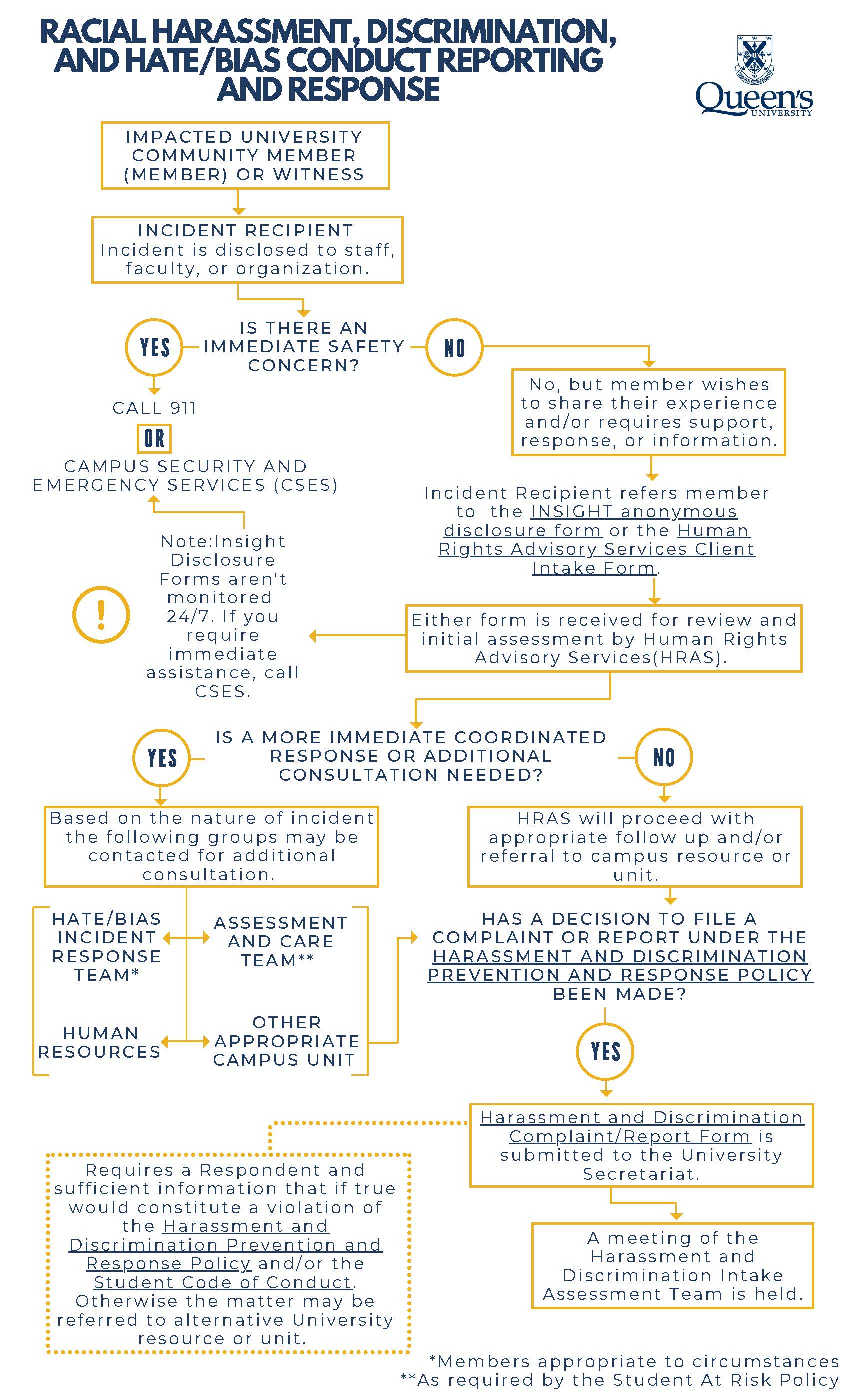1. Why does the university need a policy about harassment and discrimination?
Queen’s is committed to ensuring its environment is free from issues such as harassment and discrimination. These issues will not be tolerated at the university. A policy that clearly outlines what this behaviour is, and how it will be dealt with, is a crucial part of this commitment.
2. Who developed this new policy and procedures?
A Working Group brought together in 2018 spent over three years reviewing best practices, engaging in broad consultation, discussing its legal obligations with an external law firm, and consulting with a broad range of collaborators and Queen’s community members. The Working Group was made up of 24 faculty, staff, and student members from across the campus, all of whom worked to ensure the revised policy and procedures are inclusive and reflect best practices in the university sector.
3. What are harassment and discrimination?
We all have an idea of what these terms mean; however, for the purposes of the policy and procedures, they mean very specific things.
- Harassment is formally defined in the Policy, but in simple terms, it is when someone says or does something that they know, or should know, is unwelcome by the person or group it is directed toward. The conduct must be unwarranted, made in bad faith or otherwise not justifiable. Managers who provide direction, counsel and feedback to employees in good faith are not engaging in harassment. The same is true of constructive criticism and feedback by professors on the academic work of students. Harassment will usually require more than one or two individual incidents but the impact and gravity of incidents is relevant. One particularly extreme or impactful incident may constitute harassment.
- Discrimination is when someone, or a group of people, are treated differently than others based on certain characteristics protected by law, that results in them experiencing burdens, obligations, or disadvantages, or not having access to opportunities, benefits, or advantages available to others. The characteristics of those experiencing discrimination may relate to their race, religion, sexual identity, gender, place of origin, age, marital status, and several other characteristics laid out in section 1 of Ontario’s Human Rights Code.
More information on the words used in the policy and procedures, and what they mean, can be found in the glossary of terms.
4. When were the draft policy and procedures approved?
The university’s Board of Trustees approved the revised policy and procedures in May 2021.
5. What should I do if I want make a complaint of harassment and/or discrimination using this new policy?
Anyone who wants to make a complaint about harassment or discrimination they have experienced should complete a short online form, which is then automatically submitted to the University Secretary. The complaint will be streamed through the university’s intake process as described in the procedure related to making a complaint. You, as the “complainant”, will be communicated with throughout this process.
6. What do I do if I see someone being harassed or discriminated against, and I want to tell someone who can do something about it?
If you want to make a report about harassment and/or discrimination you have seen but not personally experienced, you should complete a short online form that is automatically submitted to the University Secretary. This report will be streamed through the university’s intake process as described in the procedure related to making a report.
7. If I make a complaint or file a report, who finds out about it? Can it be anonymous or kept confidential?
Complaints and reports made under the Harassment and Discrimination Prevention and Response Policy cannot be made anonymously. Complaints and reports are kept confidential to those people who need to see and review them in order to investigate a complaint or report that has been filed.
If you wish to file an anonymous complaint or report, you can do so through the “IN-SIGHT” tool, housed on the Human Rights and Equity Office’s website.
Step 1: Impacted University community member (member) or witness
Step 2: Incident Recipient - Incident is disclosed to staff, faculty, or organization
Is there an immediate safety concern?
YES - Call 911 or Campus Security and Emergency Services 613-533-6111
NO, but member wishes to share their experience and/or requires support, response, or information.
Step 3: Incident Recipient refers member to the INSIGHT anonymous disclosure form or the Human Rights Advisory Services Client Intake form. NOTE: Disclosure forms are not monitored 24/7. If you require immediate assistance, call Campus Security and Emergency Services.
Step 4: Either form is received for review and initial assessment by Human Rights Advisory Services (HRAS)
Is a more immediate coordinated response or additional consultation needed?
YES: Based on the nature of the incident, the following groups may be contacted for additional information:
- Hate/Bias Incident Response Team*
- Assessment and Care Team**
- Human Resources
- Other Appropriate Campus Unit
* Members appropriate to circumstances
**As required by the Students at Risk Policy
NO: HRAS will proceed with appropriate follow up and/or referral to campus resource or unit.
Has a decision to file a complain or report under the Harassment and Discrimination Prevention and Response Policy been made?
YES:
Step 5: Harassment and Discrimination Complain/Report Form is submitted to the University Secretariat. NOTE: Requires a Respondent and sufficient information that if true would constitute a violation of the Harassment and Discrimination Prevention and Response Policy and/or the Student Code of Conduct. Otherwise the matter may be referred to alternative University resource or unit.
Step 6: A meeting of the Harassment and Discrimination Intake Assessment Team is held.

Questions?
If you have any questions related to the Harassment and Discrimination Policy and Procedures, you can reach out to the following offices:
